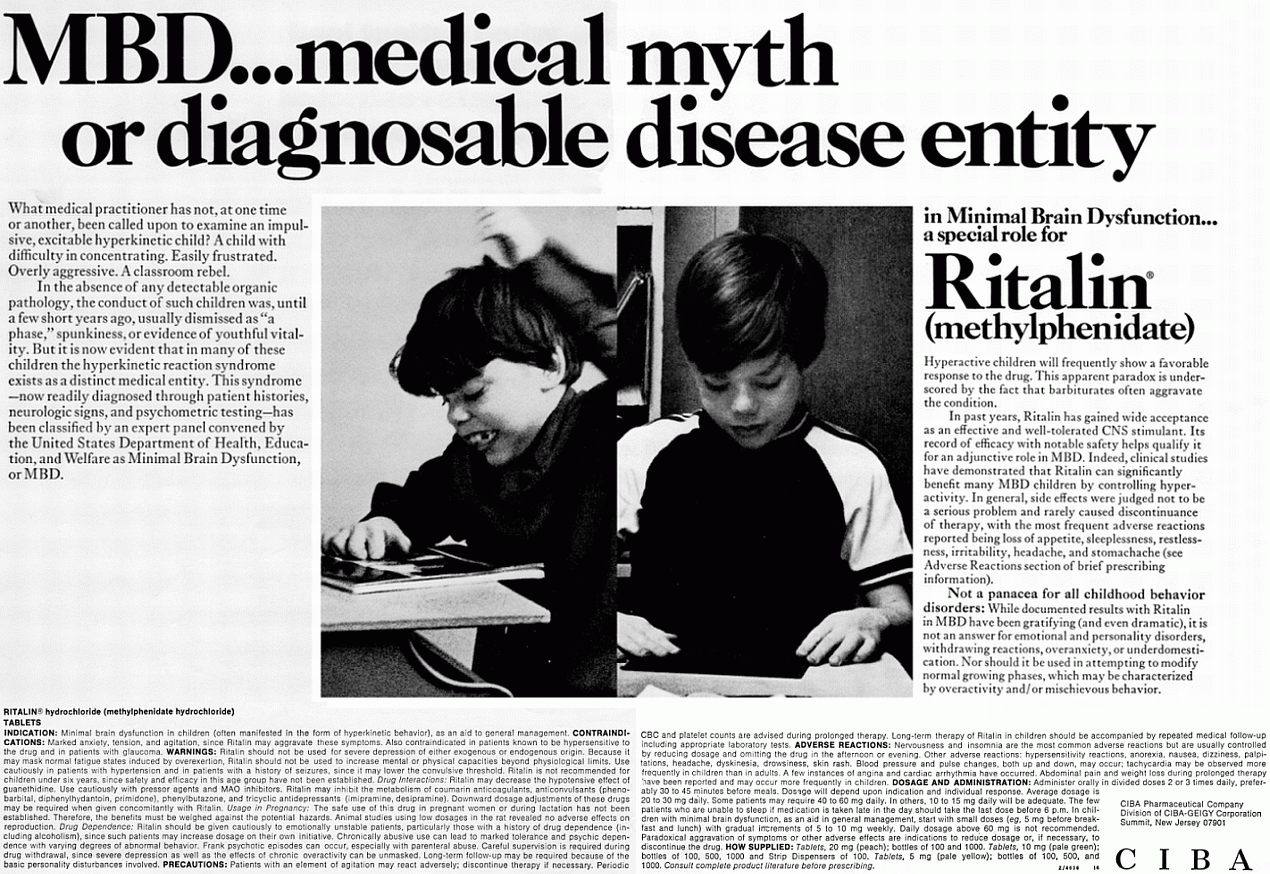
|
Ritalin advertisement, 1971. American Journal of Diseases of Children, Vol. 122, No. 2, pp. 12-13. MBD... medical myth or diagnosable disease entity What medical practitioner has not, at one time or another, been called upon to examine an impulsive, excitable hyperkinetic child? A child with difficulty in concentrating. Easily frustrated. Overly aggressive. A classroom rebel. In the absence of any detectable organic pathology, the conduct of such children was, until a few short years ago, usually dismissed as "a phase," spunkiness, or evidence of youthful vitality. But it is now evident that in many of these children the hyperkinetic reaction syndrome exists as a distinct medical entity. This syndrome -- now readily diagnosed through patient histories, neurologic signs, and psychometric testing -- has been classified by an expert panel convened by the United States Department of Health, Education, and Welfare as Minimal Brain Dysfunction, or MBD. in Minimal Brain Dysfunction... a special role for Ritalin® (methylphenidate) Hyperactive children will frequently show a favorable response to the drug. This apparent paradox is underscored by the fact that barbiturates often aggravate the condition. In past years, Ritalin has gained wide acceptance as an effective and well-tolerated CNS stimulant. Its record of efficacy with notable safety helps qualify it for an adjunctive role in MBD. Indeed, clinical studies have demonstrated that Ritalin can significantly benefit many MBD children by controlling hyperactivity. In general, side effects were judged not to be a serious problem and rarely caused discontinuance of therapy, with the most frequent adverse reactions reported being loss of appetite, sleeplessness, restlessness, irritability, headache, and stomachache (see Adverse Reactions section of brief prescribing information). Not a panacea for all childhood behavior disorders: While documented results with Ritalin in MBD have been gratifying (and even dramatic), it is not an answer for emotional and personality disorders, withdrawing reactions, overanxiety, or underdomestication. Nor should it be used in attempting to modify normal growing phases, which may be characterized by overactivity and/or mischievous behavior. RITALIN hydrochloride (methylphenidate hydrochloride) TABLETS Indication: Minimal brain dysfunction in children (often manifested in the form of hyperkinetic behavior), as an aid in general management. Contraindications: marked anxiety, tension, and agitation, since Ritalin may aggravate these symptoms. Also contraindicated in patients known to be hypersensitive to the drug and in patients with glaucoma. Warnings: Ritalin should not be used for severe depression of either exogenous or endogenous origin. Because it may mask normal fatigue states induced by overexertion, Ritalin should not be used to increase mental or physical capacities beyond physiological limits. Use cautiously in patients with hypertension and in patients with a history of seizures, since it may lower the convulsive threshold. Ritalin is not recommended for children under six years, since safety and efficacy in this age group have not been established. Drug interactions: Ritalin may decrease the hypotensive effect of guanethidine. Use cautiously with pressor agents and MAO inhibitors. Ritalin may inhibit the metabolism of coumarin anticoagulants anticonvulsants (phenobarbital, diphenylhydantoin, primidone), phenylbutazone, and tricyclic antidepressants (imipramine, desipramine). Downward dosage adjustments of these drugs may be required when given concomitantly with Ritalin. Usage in Pregnancy: The safe use of this drug in pregnant women or during lactation has not been established. Therefore, the benefits must be weighed against the potential hazards. Animal studies using low dosages in the rat revealed no adverse effects on reproduction. Drug Dependence: Ritalin should be given cautiously to emotionally unstable patients, particularly those with a history of drug dependence (including alcoholism), since such patients may increase dosage on their own initiative. Chronically abusive use can lead to marked tolerance and psychic dependence with varying degrees of abnormal behavior. Frank psychotic episodes can occur, especially with parenteral abuse. Careful supervision is required during drug withdrawal, since severe depression as well as the effects of chronic overactivity can be unmasked. Long-term follow-up may be required because of the basic personality disturbances involved. Precautions: Patients with an element of agitation may react adversely; discontinue therapy if necessary. Periodic CBC and platelet counts are advised during prolonged therapy. Long-term administration of Ritalin to children should be accompanied by repeated medical follow-up including appropriate laboratory tests. Adverse reactions: Nervousness and insomnia are the most common adverse reactions but are usually controlled by reducing dosage and omitting the drug in the afternoon or evening. Other adverse reactions : hypersensitivity reactions, anorexia, nausea, dizziness, palpitations, headache, dyskinesia, drowsiness, skin rash. Blood pressure and pulse changes, both up and down, may occur; tachycardia may be observed more frequently in children than in adults. A few instances of angina and cardiac arrhythmia have occurred. Abdominal pain and weight loss during prolonged therapy have been reported and may occur more frequently in children. Dosage and administration: Administer orally in divided doses 2 or 3 times daily, preferably 30 to 45 minutes before meals. Dosage will depend upon indication and individual response. Average dosage is 20 to 30 mg daily. Some patients may require 40 to 60 mg daily. In others, 10 to 15 mg daily will be adequate. The few patients who are unable to sleep if medication is taken late in the day should take the last dose before 6 p.m. In children with minimal brain dysfunction, as an aid in general management, start with small doses (eg, 5 mg before breakfast and lunch) with gradual increments of 5 to 10 mg weekly. Daily dosage above 60 mg is not recommended. Paradoxical aggravation of symptoms or other adverse effects are indications to reduce dosage or, if necessary, to discontinue the drug. How supplied: Tablets, 20 mg (peach): bottles of 100 and 1000. Tablets, 10 mg (pale green); bottles of 100, 500. 1000 and Strip Dispensers of 100. Tablets, 5 mg (pale yellow); bottles of 100, 500 and 1000. Consult complete product literature before prescribing. CIBA Pharmaceutical Company ~ Division of CIBA-GEIGY Corporation ~ Summit, New Jersey 07901 |